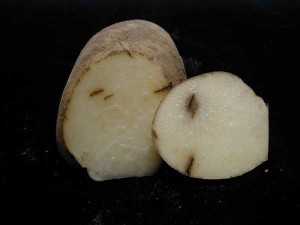Tips To Avoid Potato Bruising
As we head toward another harvest season and the mad rush it entails, now might be a good time for a few reminders and a short refresher on potato tuber bruising.
Mechanical damage to potato tubers can take the form of nicks, cuts, skinning, and bruising. All of these forms of damage can affect the final quality of your potatoes as well as the storability of the crop. In general, any type of damage that breaks the skin of the tuber is a concern because such damage provides a potential entry point for one or another of the long list of disease organisms that cause storage rots.
While nicks, cuts, and skinning are all relatively superficial (though some cuts can be very severe), bruising usually involves damage to fairly substantial portions of the tuber and may also go fairly deep. To make matters worse, some bruises remain invisible until the damaged tubers are cut.
Bruising Types
Three types of bruising occur in potato tubers. Two of these types of bruises, shatter bruise and blackspot bruise, are generally associated with the rigors of harvest, though potatoes can suffer bruise damage anytime they’re handled. The third type of pressure bruise actually occurs in the storage facility while the tubers are stationary.

Figure 1. Shatter bruise can be seen without cutting into the tuber. Tissue separation and periderm damage occur in potatoes harvested and handled when pulp temperatures are too cold. Photo(s) Credit: Dr Nora Olsen, University of Idaho, Kimberly.
1. Shatter bruise is the one type of bruise that can be observed without actually cutting into the tuber and examining the internal tissues. Shatter bruise is characterized by cracks and fissures in the tuber that break the skin (Figure 1). This type of bruise occurs readily in crisp, turgid tubers or those with a high-solid content and is often associated with potatoes that are harvested and handled when pulp temperatures are too cold.
Turgid tuber tissues respond to a physical blow by rebounding. As these forces reverberate through the tuber, they actually tear the tuber tissues apart, resulting in fissures in the tuber flesh and cracks in the skin.
2. Blackspot bruise is quite a bit different. In this case, the periderm and the somewhat more resilient tissues just beneath it will deform in response to a physical blow, but in this case, the skin doesn’t break, and the tuber tissues don’t get ripped apart. Instead, the energy from the mechanical insult is delivered to tissues deeper in the tuber. The damaged internal cells leak some of their cellular contents, and the enzymes and substrates released react with one another resulting in the internal grey to black discoloration associated with this bruise type (Figure 2).

Figure 2. Blackspot bruise, caused by a physical blow, is favored by warmer pulp temperatures and dry conditions.
Blackspot bruise is favored by warmer pulp temperatures or dry conditions that tend to leave tubers in a more flaccid state. It also appears more commonly near the stem end of the tuber.
3. Pressure bruise is very similar to blackspot in that tissue damage inside the tuber leads to discolored internal tissues. In this case, however, the mechanical force is supplied by the sheer weight of the potato pile bearing down on tubers at or near the bottom of the pile. External symptoms may appear in the form of flattened areas on the outside of affected tubers.
Recommendations For Management
Management begins with proper adjustment and operation of harvesting equipment and placement of padding in problem areas of the handling equipment. Avoid drops of more than 6 inches. Harvesting tubers in the recommended pulp temperature range of 45o F to 65o F will also help to reduce damage.
In general, both shatter bruise and blackspot bruise increase when pulp temperatures are too cold. Management of pressure bruise requires high humidity in the storage facility although reducing pile height — keep below 18 feet — can also minimize this type of bruise.










